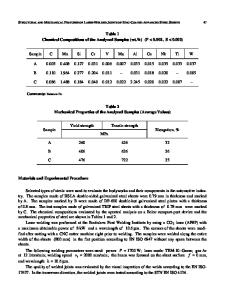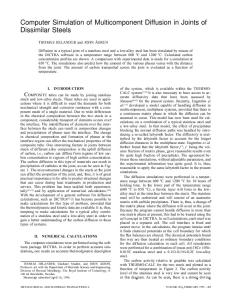Structural Transformations of the Metal of Heat-Affected Zone of Welded Joints of High-Strength Armor Steels
- PDF / 4,069,014 Bytes
- 7 Pages / 594 x 792 pts Page_size
- 54 Downloads / 312 Views
STRUCTURAL TRANSFORMATIONS OF THE METAL OF HEAT-AFFECTED ZONE OF WELDED JOINTS OF HIGH-STRENGTH ARMOR STEELS V. A. Kostin,1,2 G. M. Grigorenko,1,3 V. D. Poznyakov,1 and T. O. Zuber1
UDC 669-1:51-74:519.257
We construct the thermokinetic diagrams of austenite decomposition and analyze the influence of the rate of cooling of specimens simulating the metal of the heat-affected zone (HAZ) on the structure and durability of Quardian-500 and Armstal-500 high-strength steels. The regularities of the influence of carbon on the structure formation in the HAZ metal are determined for these steels and the susceptibility to brittle fracture is estimated. It is shown that, in Quardian-500 steel with a carbon content of 0.26%, a predominantly martensitic structure with a hardness of 4850–4890 MPa is formed in the zone of overheating for cooling rates of 20–30°C/sec, whereas in Armstal-500 steel with a carbon content of 0.29%, the transformation of overcooled austenite in the HAZ of simulating specimens occurs at cooling rates of 7–30°C/sec and is accompanied by the formation of martensitic structure with a hardness of 5160–5390 MPa, which improves the static strength of the products. Keywords: Quardian-500 and Armstal-500 special steels, phase transformations, microstructure, martensite, bainite.
Introduction It is known that the mechanical properties of the metal in the heat-affected zone (HAZ) of welded joints (WJ) are determined by its structure. The process of formation of the HAZ is affected not only by the chemical composition and the initial state of steel but also by the conditions of heating and cooling in the process of arc welding, which strongly differ from the conditions of ordinary heat treatment [1, 2]. At present, for the purposes of production of welded structures for lightly armored military equipment, it is customary to use high-strength and high-hardness steels ( HB ≥ 4400 MPa). These steels are alloyed with Cr–Ni–Mn–Mo–V and contain at least 0.25% of carbon. Their characteristics can be improved by hardening and the low tempering. Note that advanced armor steels must have high characteristics of strength, impact resistance, and fracture toughness. Moreover, these steels should be reliable, easily recoverable and repairable, well weldable, characterized by a high resistance to the action of new types of armaments (armor-piercing, cumulative, vacuum, etc.), and have a relatively low mass [3]. There are numerous grades of armor steel whose HB hardness is equal to 500 developed throughout the world. In particular, we can mention the following grades: 71 (Ukraine), Armox-500 (Sweden), Quardion-500 (Belgium), Armstal-500 (Poland), Ramor-500 (Finland), MARS-270 (France), etc. characterized not only by high hardness but also satisfying numerous other requirements to steels of this kind, which is guaranteed by the proper alloying of steels and heat treatment in the process of production of rolled products. 1 2 3
E. Paton Institute of Electric Welding, Ukrainian National Academy of Sciences, Kyiv, Ukraine. Correspon
Data Loading...











